![]()
![]()
![]()
Use LEFT and RIGHT arrow keys to navigate between flashcards;
Use UP and DOWN arrow keys to flip the card;
H to show hint;
A reads text to speech;
57 Cards in this Set
- Front
- Back
|
What is the most important immune system cell in the body (according to Dr. Pastey)?
|
The macrophage. But he's just following George Bernard Shaw's lead.
|
|
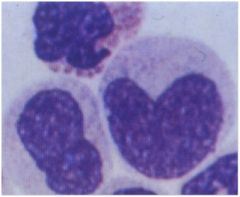
What type of white blood cell is this? How can you tell? Where would you find this cell?
|

This is a monocyte. You can tell because of the kidney bean shaped nucleus. These guys are found in the blood.
|
|
|
What is a macrophage called in the brain?
|
Microglia
|
|
|
What is a macrophage called in bone?
|
Osteoclast
|
|
|
What is a macrophage called in a blood vessel?
|
Mesangial cell
|
|
|
What is a macrophage called in connective tissue?
|
Histiocyte
|
|
|
What is a macrophage called in the liver?
|
von Kupffer cell
|
|
|
What is a macrophage called in the lung?
|
Alveolar macrophage
|
|
|
What is a macrophage called in the skin?
|
Langerhans cell
|
|
|
What is a macrophage called in the lymphatic organs?
|
Dendritic cell
|
|
|
What is a macrophage called in a granuloma?
|
Epitheloid
|
|
|
What are the most potent antigen presenting cells? Why?
|
Langerhans cells and dendritic cells. They act locally, then take their antigens for presentation at a local lymph node to stimulate a cell-mediated immune response. The other macrophage types secrete chemoattractants and interleukins locally, but don't go anywhere.
|
|
|
Do macrophages phagocytose something and then die, or keep going?
|
Macrophages can repeatedly phagocytose.
|
|
|
How do macrophages interact with B and T cells?
|
They secrete substances that initiate and amplify the response by B and T cells.
|
|
|
What do the cytokines that macrophages produce induce?
|
inflammation, pyrexia, lethargy, anorexia and more
|
|
|
How are macrophages different from neutrophils? (4)
|
Macrophages respond in a day or two, where neutrophils respond in 6-8 hours.
Neutrophils hone to sites of infection and release chemotactic factors to attract macrophages. Macrophages and neutrophils both use the respiratory burst mechanism, but use catalase instead of myeloperoxidase. In addition to respiratory burst, they kill by nitric oxide (except in humans, pigs, goats, or rabbits), where neutrophils don't use that method. |
|
|
What are the three types of activation by macrophages? What is the difference between them (what is their fx, by what are they triggered)?
|

Innate activation - triggered by TLRs, have inflammatory products. The most common form - results in phagocytosing
Alternative activation - not involved in destruction, but healing Immune activation - triggered by IFNy, IL-12 and TNFa. Phagocytoses intracellular bacteria. |
|
|
Is M1 or M2 involved in the killing?
|
M1 macrophage is involved in the killing (innate and immune activation). M2 macrophage is involved in the healing (alternative activation).
|
|
|
How do macrophages kill by nitric oxide? In what species do macrophages kill by nitric oxide?
|
NO binds to metal binding enzymes which are important in bacterial DNA synthesis. So in effect, NO blocks DNA synthesis.
Cattle, sheep, horses and rodents use this mechanism. |
|
|
What is the substance released by macrophages that kills through oxidative and nonoxidative mechanisms?
|
Lysosomes
|
|
|
What complements do macrophages release?
|
C2, C3, C4, and C5
|
|
|
What are the substance released by macrophages that dissolve damaged or necrotic tissue?
|
Proteases, elastases, collagenases, plasminogen activator.
|
|
|
What are the healing factors released by macrophages?
|
Angioblastic and fibroblastic cytokines.
|
|
|
What are the inflammatory cytokines produced by macrophages? What do they induce besides inflammation?
|
IL1, IL6, TNFa
They also induce anorexia and pyrexia |
|
|
What type of toxin produces septic shock syndrome? What kind of bacteria produces that toxin?
|
Septic shock syndrome produced by endotoxins of gram negative bacteria
|
|
|
What type of toxin produces toxic shock syndrome? What kind of bacteria produces that toxin?
|
Toxic shock syndrome produced by exotoxins of gram positive bacteria
|
|
|
What are the acute phase proteins? What is their purpose?
|
SAA (serum amyloid A), SAP (serum amyloid P), MBP (mannose binding proteins), C-reactive protein
Acute phase proteins are used to reduce and control the inflammation. |
|
|
What cytokine activates Th-2 cells? What immune produces them?
|
IL-1
Produced by antigen-presenting cells (APC) |
|
|
What interleukin activates Th-2? What immune cell produces it? What does it promote?
|
Interleukin-6 is produced by macrophages and other APC acts on Th-2 cells to promote antibody synthesis
|
|
|
What interleukin stimulates Th-1 cells to produce IL-2 and IFNy and other cytokines?
|
IL-12
|
|
|
What is the triphasic process of clearing soluble antigens?
|

distribution, catabolism and immune elimination
Distribution decreases concentration as the antigen dilutes out to the different organs. After 6-7 days, the antibodies are produced, which leads to immune elimination. |
|
|
What cells remove the intravenous antigens in dogs, rodents and humans?
|
Kupffer cells in the liver
|
|
|
What cells remove the intravenous antigens in ruminants, cats, equine and pig?
|
Pulmonary intravascular macrophages
|
|
|
What cells remove the antibody coated antigen?
|
Spleenic macrophages will remove antigens coated in antibody in all species.
|
|
|
What cells remove the complement coated antigen?
|
Liver macrophages
|
|
|
What cells remove intradermal antigen?
|
Langerhans dendritic cells
|
|
|
What cells remove intranasal antigen
|
Alveolar macrophages
|
|
|
What cells remove intramuscular antigen and antigens from the digestive tract?
|
Lymph node dendritic cells and macrophages.
|
|
|
What respective percentages are antigens removed from the liver and the lungs in the dog and cat?
|
80% liver/6.5% lungs in the dog.
14% liver/86% lungs in the cat. |
|
|
What is the difference in time of clearance in a body with antibody response and without?
|
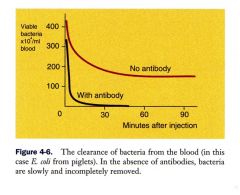
The opsonization by antibodies (as in a secondary response to an antigen) signifigantly drops the response time from the first interaction with no antibodies yet.
|
|
|
If the stimulus is nonimmunogenic, then ___________ are included in the granuloma formation
|
Giant cells - accumulated macrophages fused to be a giant cell with many nuclei
nonimmunogenic stimulus would be like mineral oil. |
|
|
If the stimulus is immunogenic, then ___________ are included in the granuloma formation
|
lymphocyte infiltration
immunogenic stimulus would be like mycobateria |
|
|
If the stimulus is toxic to macrophages, then ___________ are included in the granuloma formation
|
excessive tissue damage and local scarring
Stimuli toxic to macrophages would be like asbestos. |
|
|
What happens if macrophages try to remove a foreign material and cannot?
|
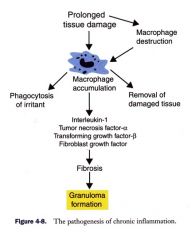
This results in persistent stimulus (chronic inflammation), which leads to more macrophages, fibroblasts, excessive collagen, loose CT and new blood vessels, which all lead to granuloma.
|
|
|
What is excessive collagen called?
|
fibrosis
|
|
|
Neutrophils secrete lipoxins in the recovery from inflammation. What part do they play?
|
Suppress leukotriene synthesis.
|
|
|
Macrophages secrete serine protease inhibitor and interferon gamma in the recovery from inflammation. What part do they play?
|
Serine protease inhibitor inhibits elastase and oxidants. It protect TGF-b (the anti-inflammatory cytokine)
|
|
|
TGF-b - inflammatory cytokine or anti-inflammatory cytokine? What relationship does it have with serine protease inhibitor?
|
Anti-inflammatory.
Serine protease inhibitor is released from macrophages in the recovery of inflammation, the protease inhibitor protects TGF-b to combat the inflammatory response. |
|
|
Which cytokines inhibit the release of TGFa? What role does TGFa play in the recovery from inflammation?
|
IL-10 and TGF-b are anti-inflammatory cytokines because they block the release of TGF-a, a cytokine that is inflammatory.
|
|
|
What are the acute phase proteins? What are their role?
|
SAA, SAP, and CRP (c-reactive protein) are the acute phase proteins, so named because their synthesis is associated with acute infections and inflammation. They enhance phagocytosis and promote healing.
|
|
|
Which of the consequences of septic shock actually lead to the death? Which type of bacterial toxin leads to septic shock?
|
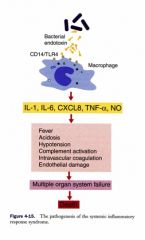
Bacterial endotoxins lead to septic shock.
Endothelial damage and intravascular coagulation cause the eventual death. |
|
|
What is pathogenesis of toxic shock?
|

The macrophages react to the bacterial exotoxins and bind "permanently" to the helper cells. This cause and overproduction of IL1 and TNFa with leads to organ failure and death.
|
|
|
What is the definition of amyloidosis?
|
The abnormal deposition of insoluble protein in tissues leading to loss of organ function.
The important thing is that this is a deposition of INSOLUBLE protein in tissue. |
|
|
What is reactive amyloidoses?
|
Deposits of misfolded SAA. Indicates chronic, uncontrolled suppurative or autoimmune conditions.
|
|
|
What is immunogenic amyloidosis?
|
Deposits of misfolded antibody light chains (myelomas)
|
|
|
What is the difference between Mad Cow Disease and Alzheimer's Disease?
|
Mad cow is prion deposition in the neurons.
Alzheimer's is amyloid fibril deposition in the neurons. |
|
|
What is the pathogenesis that leads to amyloid fibril deposition?
|
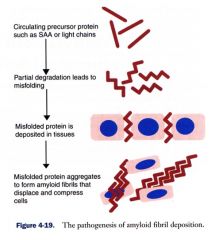
The circulating proteins misfold and deposit and draw other proteins out of solution to deposit with them.
|

